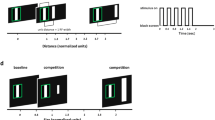Summary
The orienting behavior ofAplocheilus lineatus with intact, partially and totally ablated neuromasts to single surface wave trains was investigated.
-
1.
Blinded fish with intact lateral line system localize the direction and the distance of a wave source within the tested range of 18 cm.
-
2.
With only one neuromast left intact the fish remain sensitive to surface waves from all directions although their ability to locate the stimulus direction is now absent. The observed turning responses depend solely on the topographic position of the neuromast: A rostral position results in a small turn, a caudal one in a large turn.
-
3.
Distance localization of such fish as indicated by the magnitude of forward movement during an evoked response still exists and is only somewhat reduced. It is independent of target angle.
-
4.
Complete unilateral ablation of neuromasts results in at least a partially misinterpretation of target angles. Stimuli approaching the intact body side cause well differentiated responses, whereas those impinging first upon the side depleted from neuromasts cause turns directed away from the wave source.
-
5.
Fish without any neuromasts react to surface waves roughly directed. Their reaction time is extraordinarily prolonged, the responsiveness extremely reduced; no distance localization at all can be observed. We therefore conclude, that this type of reaction is mediated by receptors different from neuromasts and not intermingled with the neuromast mediated ones.
-
6.
The functional significance of a “place effect” of individual neuromasts on the mechanism of orienting behavior is discussed.
Similar content being viewed by others
References
Batschelet E (1965) Statistical methods for the analysis of problems in animal orientation and certain biological rhythms. Am Inst Biol Sci, Washington, DC
Bleckmann H (1980) Reaction time and stimulus frequency in prey localization in the surface feeding fishAplocheilus lineatus. J Comp Physiol 140:163–172
Bleckmann H, Schwartz E (1982) The functional significance of frequency modulation within a wave train for prey localization in the surface feeding fishAplocheilus lineatus (Cyprinidontidae). J Comp Physiol 145:331–339
Bleckmann H, Topp G (1981) Surface wave sensitivity of the lateral line organs of the topminnowAplocheilus lineatus. Naturwissenschaften 67:624
Bleckmann H, Waldner I, Schwartz E (1981) Frequency discrimination of the surface feeding fishAplocheilus lineatus — A prerequisite for prey localization? J Comp Physiol 143:485–490
Brownell P, Farley R (1979) Orientation to vibrations in sand by the nocturnal scorpionParuroctonus mesaensis: Mechanism of target localization. J Comp Physiol 131:31–38
Dijkgraaf S (1934) Untersuchungen über die Funktion der Seitenorgane an Fischen. Z Vergl Physiol 20:162–214
Dijkgraaf S (1963) The functioning and significance of the lateral-line organs. Biol Rev 38:51–105
Flock Å (1965) Electron microscopic and electrophysiological studies on the lateral-line canal organ. Acta Otolaryngol [Suppl] (Stockh) 199:1–90
Görner P (1963) Untersuchungen zur Morphologie und Elektrophysiologie des Seitenlinienorgans vom Krallenfrosch (Xenopus laevis). Z Vergl Physiol 47:316–338
Görner P (1973) The importance of the lateral line system for the perception of surface waves in the clawed toadXenopus laevis. Experientia 29:295–296
Görner P (1976) Source localization with labyrinth and lateral line in the clawed toad (Xenopus laevis). In: Schuif A, Hawkins AD (eds) Sound reception in fish. Elsevier, Amsterdam, pp 171–184
Kramer G (1933) Untersuchungen über die Sinnesleistungen und das Orientierungsverhalten vonXenopus laevis. Zool J Physiol 52:629–676
Lang H (1980) Surface wave discrimination between prey and nonprey by the backswimmerNotonecta glauca L. (Hemiptera, Heteroptera). Behav Ecol Sociobiol 6:233–246
Markl H, Wiese K (1969) Die Empfindlichkeit des RückenschwimmersNotonecta glauca L. für Oberflächenwellen des Wassers. Z Vergl Physiol 62:413–420
Murphey RK (1973) Mutual inhibition and the organization of a non-visual orientation inNotonecta. J Comp Physiol 84:31–40
Murphey RK, Mendenhall B (1973) Localization of receptors controlling orientation to prey by the backswimmerNotonecta undulata. J Comp Physiol 84:19–30
Partridge BL, Pitcher TJ (1980) The sensory basis of fish schools: Relative roles of lateral line and vision. J Comp Physiol 135:315–325
Rath M (1980) Zur Richtungslokalisation von Beuteobjekten beiAplocheilus lineatus. Ausschaltexperimente und ihre mathematischen Grundlagen. Staatsexamensarbeit Universität Giessen
Schwartz E (1965) Bau und Funktion der Seitenlinie des Streifenhechtlings (Aplocheilus lineatus). Z Vergl Physiol 50:55–87
Schwartz E (1971) Die Ortung von Wasserwellen durch Oberflächenfische. Z Vergl Physiol 74:64–80
Schwartz E (1970) Ferntastsinne von Oberflächenfischen. Z Morphol Tiere 67:40–57
Unbehauen H (1980) Morphologische und elektrophysiologische Untersuchungen zur Wirkung von Wasserwellen auf das Seitenlinienorgan des Streifenhechtlings (Aplocheilus lineatus). Dissertation, Universität Tübingen
Waldner I (1981) Habituation vonAplocheilus lineatus auf Oberflächenwellen des Wassers. Dissertation, Universität Giessen
Wiese K (1972) Das mechanorezeptorische Beuteortungssystem vonNotonecta. I. Die Funktion des tarsalen Scolopidialorgans. J Comp Physiol 78:83–102
Wiese K (1974) The mechanoreceptive system of prey localization inNotonecta. II. The principle of prey localization. J Comp Physiol 92:317–325
Wiese K, Wolnik F, Jebram D (1980) The protective reflex ofBowerbankia (Bryozoa): Calibration and use to indicate movements of the medium beneath a capillary surface wave. J Comp Physiol 137:297–303
Author information
Authors and Affiliations
Additional information
Supported by Deutsche Forschungsgemeinschaft, grant no. Schw. 21/5
Rights and permissions
About this article
Cite this article
Müller, U., Schwartz, E. Influence of single neuromasts on prey localizing behavior of the surface feeding fish,Aplocheilus lineatus . J. Comp. Physiol. 149, 399–408 (1982). https://doi.org/10.1007/BF00619155
Accepted:
Issue Date:
DOI: https://doi.org/10.1007/BF00619155



